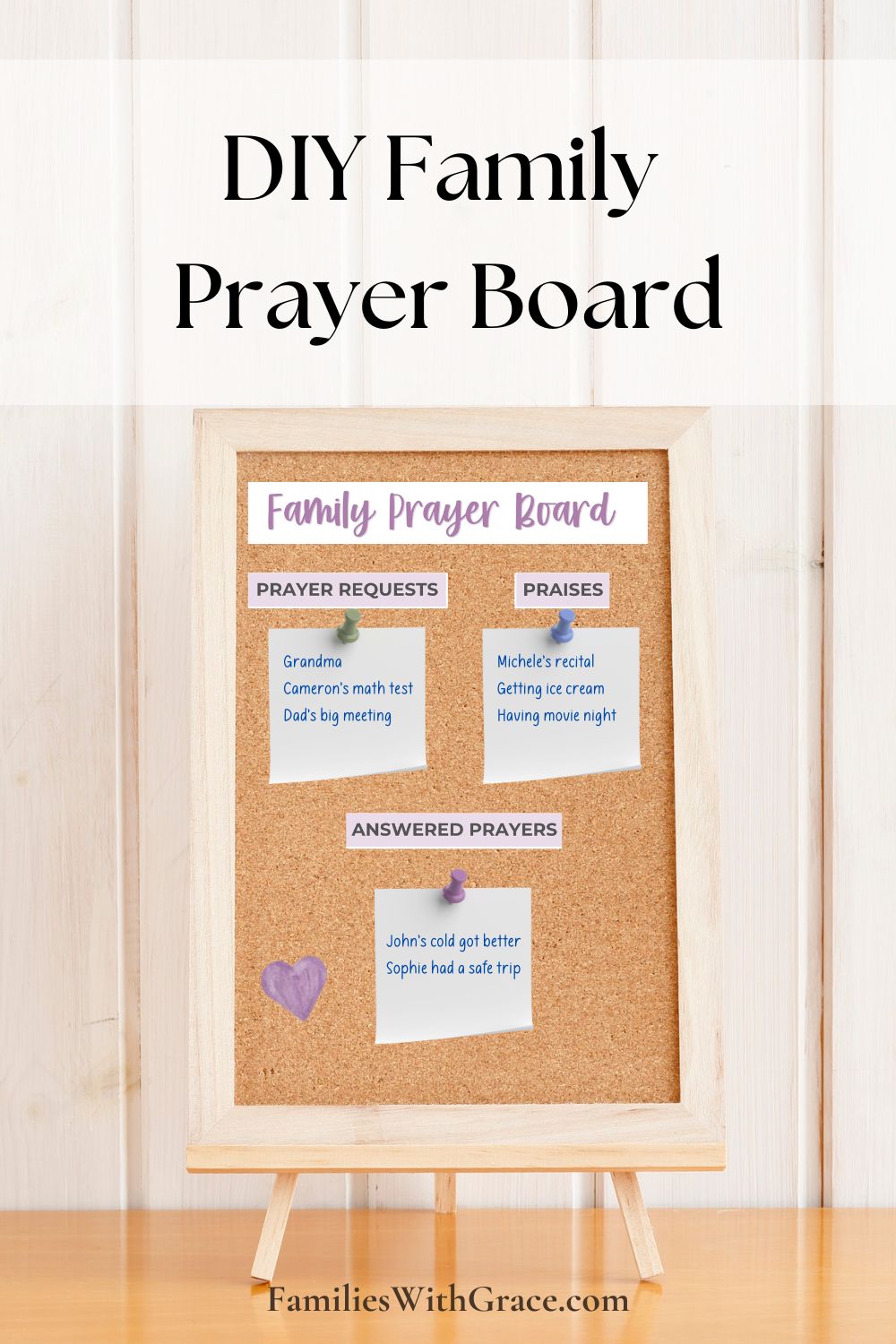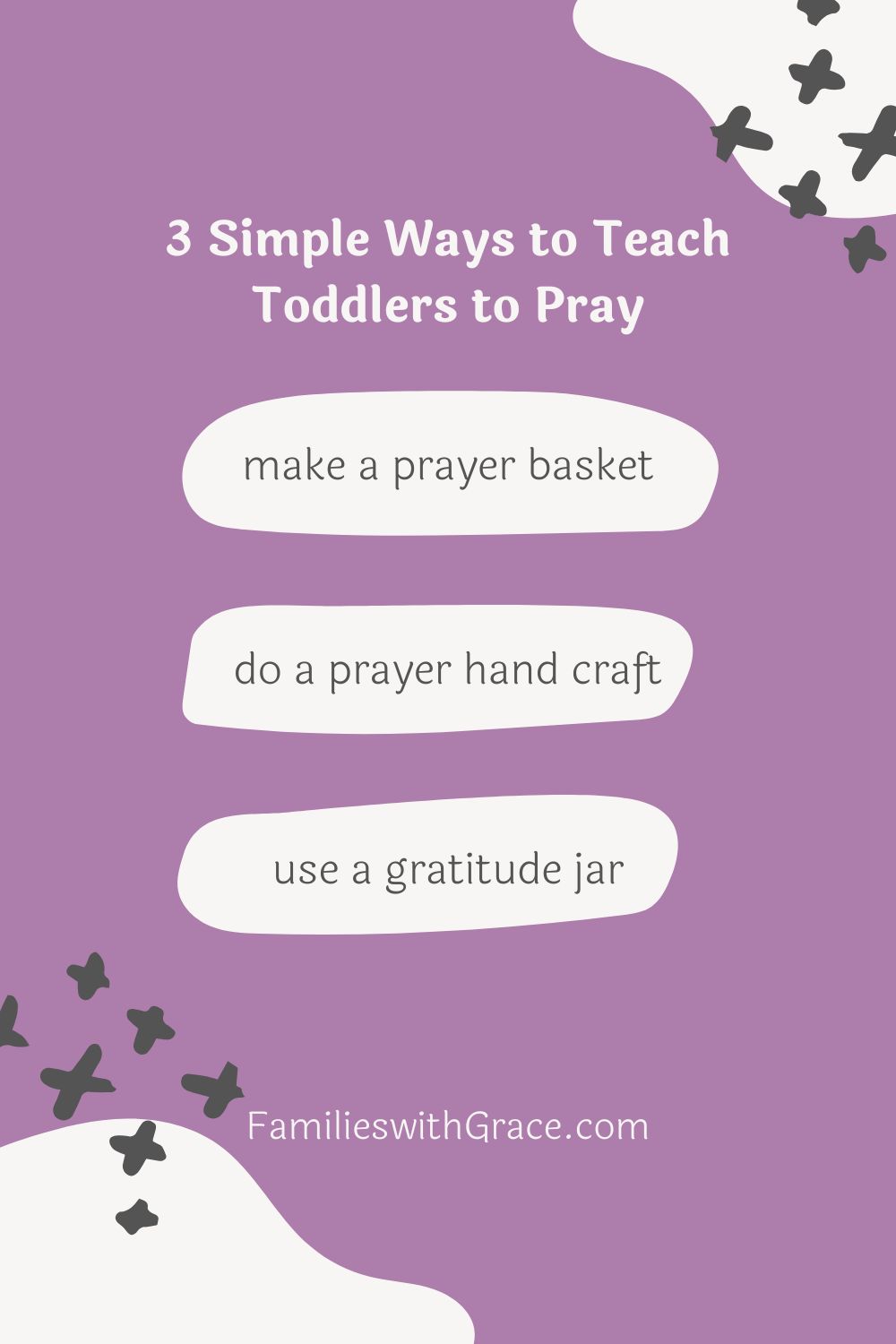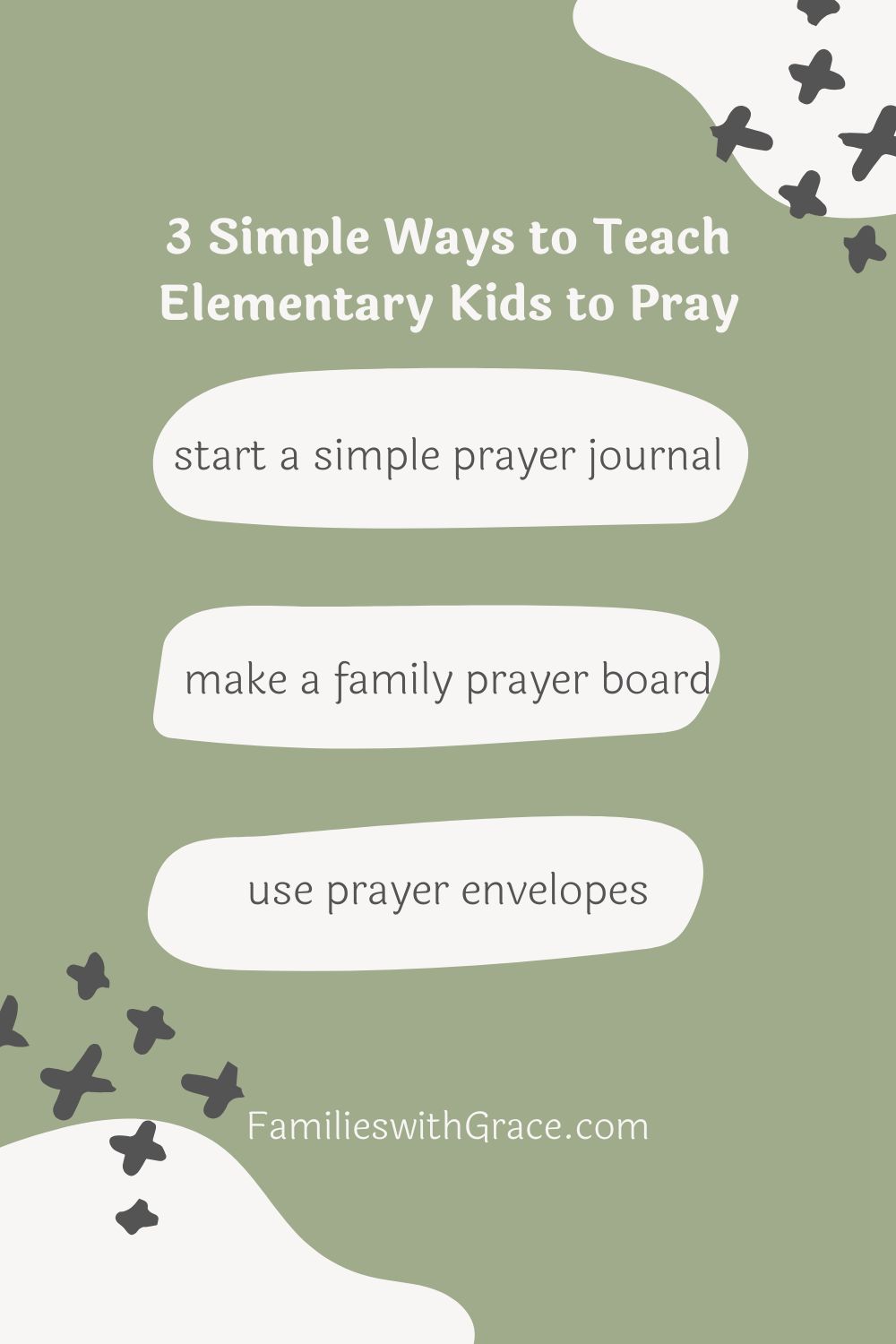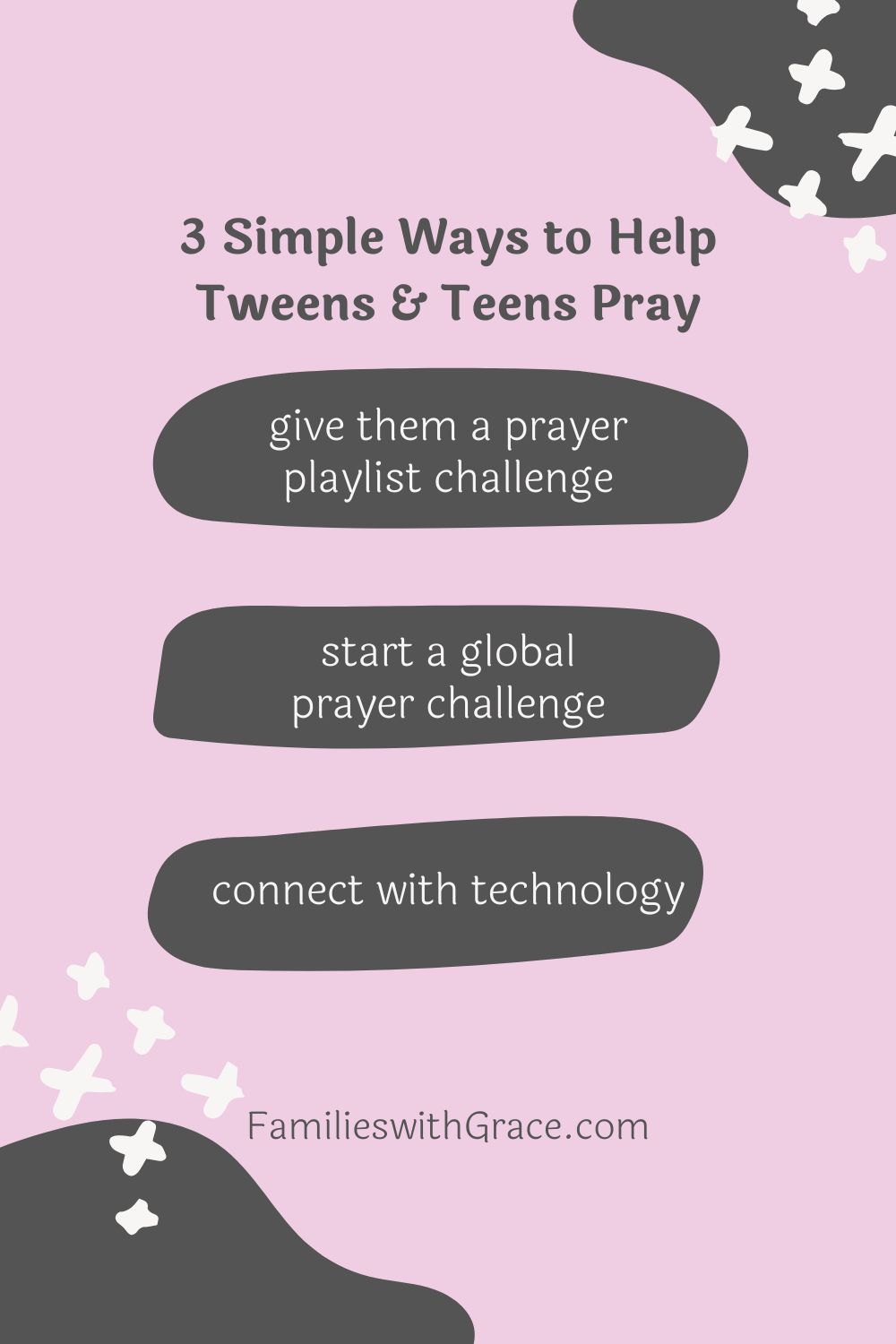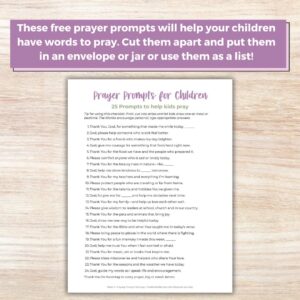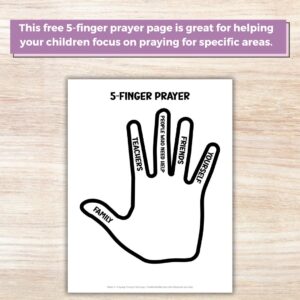Age-by-age prayer lessons and activities that really stick
Teaching children to pray isn’t about creating mini-theologians. It’s about giving our kids a lifeline to the God who loves them unconditionally.
Just like the disciples who asked Jesus, “Lord, teach us to pray” (Luke 11:1-4), our children need guidance—and we need grace.
Prayer fits into real life: sticky fingers at dinner, late-night homework stress and chaotic car lines. It’s not about perfection; it’s about connection.
And that’s exactly what we are focusing on this week in the free Bible study for moms, “Praying Through the Busy.” Because along with wanting to grow in our own prayer lives, we want to teach our children how to pray.
This post is part of the “Praying Through the Busy” free Bible study. Find all the details:
Scroll to the bottom of the post for the link to download the free study guide, reflection questions, reading plan, prayer prompts and more for the week.
Preparing your own heart
Just like in everything we do as mamas, starting by preparing our own hearts and spending time in prayer is the first step.
We can’t do it on our own. Well, we can certainly try, but it never goes as well as when we have God’s help!
Even a simple, short prayer like “God, help me teach my kids to pray,” works well. (Scroll to the bottom for a more in-depth prayer.)
As you are teaching children to pray, make sure you are spending your own time talking to God and asking Him for guidance. We want our kiddos to learn to truly connect with their Heavenly Father, not just go through the motions.

Early on, for example, my son was often sick. A few months after he was born, his big sister started preschool and brought lots of germs home. We went FOREVER with someone constantly sick.
When my son started praying as a toddler, his prayer always included, “Jesus, help me feel better.”
That’s incredibly sweet, but as time went by, those words just became routine and he said them no matter what — even when he was perfectly healthy.
Even as an adult, I struggle with getting stuck in prayer ruts. So, we want to make sure we are intentionally teaching children to pray with the mindset it is a conversation with God and not just words we repeat.
Real-life prayer roadblocks (and quick fixes!)
Even the most determined mama hits a few speed bumps when teaching children to pray. Let’s tackle some of the biggest ones that pop up for most families at some point.
1. “We don’t have time!”
Between soccer practice, homework and chaotic car lines, prayer can feel like one more thing on the checklist.
Instead of adding a brand-new slot to your schedule, tie prayer to a rhythm you already have—the first bite of dinner, the seat-belt click or lights-out at night.
If the evening is wild, fall back on a two-sentence rule: “Lord, thanks for today. Help us rest well. Amen.” Consistency beats length every time.
Small times of prayer really add up. For example, praying together for just 60 seconds at bedtime will result in an extra 6 hours of family prayer time over the next six months—without adding a single item to your calendar.
2. “Praying out loud feels awkward.”
Kids—and plenty of adults—worry they’ll “say it wrong.” Start first with being honest: “I still get nervous sometimes, but God loves hearing from us.” Your authenticity gives them permission to try.
Start small: try echo prayers (you speak one short line, they repeat it) or a quick “thank-you round” where each person names one thing they’re grateful for.
If words still stick, let them hold something tangible—a favorite photo, a verse card, even a smooth stone—as a quiet reminder that prayer is simply talking to a loving Father. Authenticity always trumps eloquence, and we’ll dive into more hands-on ideas in the sections below.
Another easy way to help children (and adults) with praying out loud is by using prayer prompts. Download a list of free prayer prompts here!
(And be sure to check out the prayer prompt, age-specific cards for toddlers through teens in the premium bundle for the week!)
3. Short attention spans and endless screens
Little ones wiggle, and older kids’ phones buzz non-stop. Keep early prayer activities for kids brief—think 30-second bursts instead of 10-minute marathons.
A one-sentence gratitude in the car line or a quick “help me, Jesus” breath prayer before a math test models that talking with God fits into real life. (We’ll dive into specific age-based ideas in a moment.)
Distraction is another good strategy for teaching children to pray, especially when they are little. Try a coloring page to help them hold still and focus.
(Download a free prayer coloring page here!)
4. Doubts, questions and eye-rolls
Tweens and teens can spot forced spirituality a mile away. Welcome their questions—God can handle them—and invite input: “What’s one issue you’d like us to pray about this week?”
When they choose the topic, they buy into the process. Remind them prayer isn’t magic words; it’s conversation with a Father who’s big enough for honest doubt.
Prayer lessons for every age: practical strategies
Talking with and teaching children to pray changes with them. The concept remains the same, but the topics shift dramatically from a toddler to a teen.
So, we’re going to break it down into age groups, but you can use any of these ideas for any age if you think they’d work well in your family!
Toddlers and preschoolers: Planting prayer seeds
For toddlers and preschoolers, prayer can be challenging to understand because it is a bit abstract. So, we want to find ways to make it more tangible, understandable and relatable for little ones.
Keeping prayers short (one or two sentences even), simple and fun are the best ways to pray with toddlers and preschoolers.
Object lessons on prayer are a great way to help them grasp the concept. Try some of these ideas:
Make a prayer basket
Fill a small basket with:
- Picture cards of family members
- Photos of favorite things
- A cuddly “prayer bear” (or any soft, stuffed animal)
Introduce the prayer basket to your child as something we’re going to use to thank God. Let them cuddle with their “prayer bear” they only use at prayer time, and have them pull a card out of the basket.
Then help them simply pray and say, “God, thank you for ____________ (whatever is on the card) Amen.”
This is a great way to introduce them to prayer and to the concept that God gives us the good things in our lives.
Make a prayer hand craft reminder
Trace your child’s hand on a piece of paper and then label each finger with the following prayer prompts:
- Thumb: Family
- Pointer: Teachers/Leaders
- Middle finger: People who need help
- Ring finger: Friends
- Pinky: Yourself
During prayer time, refer to the page and help your child pray for one thing per topic on each finger.
The prayer might be something like: Dear God, keep mommy and daddy safe. Thank you for my nursery school teacher. Help my friend Elizabeth feel better. Thank you for my friends Elizabeth and Katie. Help me learn to share with my little brother. Amen.
(Download a free, premade version of the 5-Finger Prayer Method here.)
Make a gratitude jar to celebrate God’s goodness
Daily, drop a bead or marble into a jar for each blessing you and your family name. When the jar is full, plan a special family night.
Elementary kids: Deepening the conversation
As children get older into elementary school, we want to encourage them to go deeper in their prayer lives and connect with God in new ways.
During these years, teaching children to pray is all about helping them truly understand prayer as a conversation with God. Reminding them they can talk to God about anything at any time is important.
When your child asks why we pray “all the time,” read 1 Thessalonians 5:16-18—“Rejoice always… pray continually… give thanks in all circumstances.” Then brainstorm quick “pop-up prayers” they can whisper during recess or math class.
Try some of these prayer activities for kids to help them learn to pray:
Start a simple prayer journal
You can make a prayer journal to use as a family or for your children to use on their own. For younger elementary students, a family prayer journal might work best. While older elementary students might enjoy having their own.
You can use a simple notebook or download this free prayer journal page. Keep it simple with three sections: requests, answers and praises.
A prayer journal is a great way for children (and adults!) to track and celebrate God’s responses.
Put up a family prayer board
Use a cheap cork board, wall space or even the side of your refrigerator to make a family prayer board.
Write down prayer requests each day or week on sticky notes or index cards to go on the board. When a prayer is answered, let your children decorate that card with stickers and move it to a different area.
This is a very tangible way for your children to see prayer requests and God at work.
(Download a prayer board page and labels in this week’s premium bundle!)
Make prayer envelopes
A lot like prayer baskets for toddlers and preschoolers, prayer envelopes are a simple and impactful way to help your children remember to pray for others.
You just need two envelopes of whatever size you have. Letter-sized or 5 x 7-inch ones work well.
Label one envelope: “To Pray For” and the other one “Prayed For.” Let your kiddos decorate the envelopes if they want.
Have your children make a list of people in their lives they’d like to pray for: family members, friends, teachers, specific prayer needs, etc. (My kiddos also included pets in theirs!)
Cut the list apart into strips, fold them and put them in the “To Pray For” envelope.
During prayer time, have your child draw a slip of paper from the envelope to pray for and then place it in the “Prayed For” envelope. You can rotate through the slips as many times as you want.
Tweens and teens: Authentic spiritual conversations
Prayer lessons for older kids is all about authenticity. Tweens and teens of can smell forced spirituality a mile away. This phase of teaching children to pray is more about cheering them on from the sidelines.
These ages are also when kid start questioning faith and having doubts more often. It’s a good time to remind them that God is good with difficult questions.
I’ve told my own two kiddos God can stand up to any question we have. If He couldn’t, then He wouldn’t be a God worth serving.
Though this phase of parenting may not look like nightly bedtime prayers, still find times to offer to pray with your children and remind them you are praying for them as well.
To help your tweens and teens grow even more in their prayer lives, try these ideas:
Give them a prayer playlist challenge
Music is powerful. During middle and high school, kids are usually naturally drawn to it.
So challenge your children to create a playlist of their favorite worship music. Encourage them to do some journaling or voice-memo prayers while listening.
Start a global prayer challenge
To help your tweens and teens start thinking about the world outside as a whole, start a global prayer challenge by picking a new country each week or month.
Research the prayer needs in that country together, and then commit to praying for them as a family or individually.
You can also keep this closer to home and do a national prayer challenge. My children are aware of a variety of alarming current events in our country, and we often talk about the importance of praying for such things.
Connect with technology
Use technology to your advantage and start a group text prayer chain in your family. A simple text thread where your kiddos (or you and your husband) can drop a prayer need or praise is a low-pressure way to keep prayer on their minds.
Oftentimes texting something is easier for kids at these ages than saying it.
A shared prayer app can be similar. Shared prayer apps are great for helping you remember prayer needs and also share them with others if you so choose.
(My personal favorite is PrayerMate, which is completely free.)
A mom’s prayer for teaching children to pray
Remember, mama: Prayer isn’t another chore on the family checklist; it’s the lifeline that makes the rest of the list lighter.
Whether you squeeze in a two-sentence car-line prayer or a deep teen conversation at 11 p.m., you’re modeling a faith that flexes with real life—and that example is what sticks long after the sticky fingers are gone.
Let’s conclude with a prayer you can pray right now to help you teach your children to pray:
Dear God, thank you for allowing us to talk with you freely and openly. I ask that you help me in teaching my children to pray and talk with you. Give me creativity in teaching my littles to pray. Help me to have patients when wiggly bodies won’t hold still. Fill me with your words as I give instructions and pray out loud with my family. Father, help me to get out of your way so you can move in my children’s lives. Give me wisdom and discernment to guide them in prayer. Remind me that every simple prayer we pray together plants a seed for a lifetime. Lord, teach my children to hear your voice, love your Word and lean on you in every season. In Jesus’ name, Amen.
Find more tips and Scripture prayers in the free “Praying Through the Busy” Bible study:






